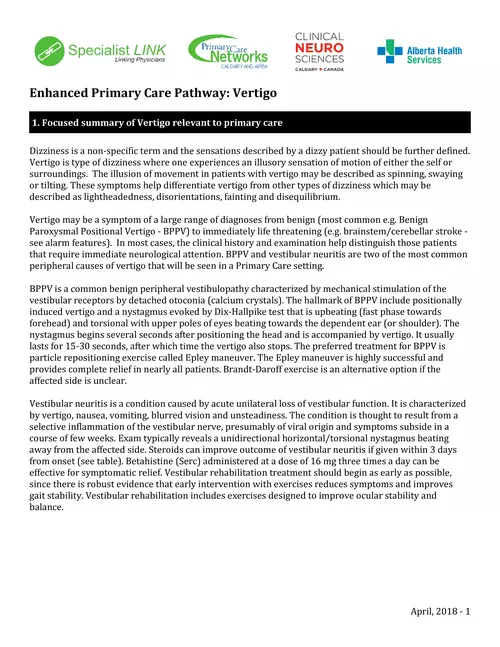
Enhanced Primary Care Pathway: Vertigo - Specialist Link
Epley maneuver + Video. http://www.entdr.com/dizziness.html. Accessed July 17, 2010. 9. Semont A, Freyes G,
adsPart of the document
1. Focused summary of Vertigo relevant to primary care
Dizziness is a non
-specific term and the sensations described by a dizzy patient should be further defined.
Vertigo is type of dizziness where one experiences
an illusory sensation of motion of either the self or
surroundings. The illusion of movement in patients with vertigo may be described as spinning, swaying
or tilting. These symptoms help differentiate vertigo from other types of dizziness which may be
described as lightheadedness, disorientations, fainting and disequilibrium.
Vertigo may be a symptom of a large
range of diagnoses from benign (most common e.g. Benign
Paroxysmal Positional Vertigo - BPPV) to immediately life threatening (e.g. brainstem/cerebellar stroke
-
see alarm features). In most cases, the clinical history and examination help distinguish those patients
that require immediate neurological attention. BPPV and vestibular neuritis are two of the most common
peripheral causes of vertigo t
hat will be seen in a Primary Care setting.
BPPV is a common benign peripheral vestibulopathy characterized by mechanical stimulation of the
vestibular receptors by detached otoconia (calcium crystals). The hallmark of BPPV include positionally
induced
vertigo and a nystagmus evoked by Dix-Hallpike test that is upbeating (fast phase towards
forehead) and torsional with upper poles of eyes beating towards the dependent ear (or shoulder). The
nystagmus begins several seconds after positioning the head and
is accompanied by vertigo. It usually
lasts for 15
-30 seconds, after which time the vertigo also stops. The preferred treatment for BPPV is
particle repositioning exercise called Epley maneuver. The Epley maneuver is highly successful and
provides complete relief in nearly all patients. Brandt-Daroff exercise is an alternative option if the
affected side is unclear.
Vestibular neuritis is a condition caused by acute unilateral loss of vestibular function. It is characterized
by vertigo, nausea, vomiting, blurred vision and unsteadiness. The condition is thought to result from a
selective inflammation of the vestibular nerve, presumably of viral origin and symptoms subside in a
course of few weeks. Exam typically reveals a unidirectional horizontal/torsional nystagmus beating
away from the affected side. Steroids can improve outcome of vestibular neuritis if given within 3 days
from onset (see table). Betahistine (Serc) administered at a dose of 16 mg three times a day can be
effective for symptomatic relief. Vestibular rehabilitation treatment should begin as early as possible,
since there is robust evidence that early intervention with exercises reduces symptoms and improves
gait stability. Vestibular rehabilitation includes exercises designed to improve ocular stability and
balance.


